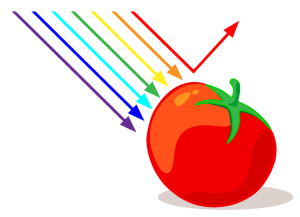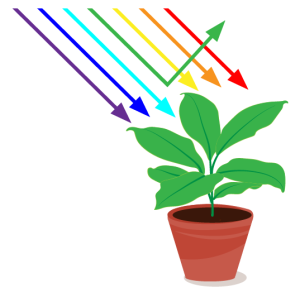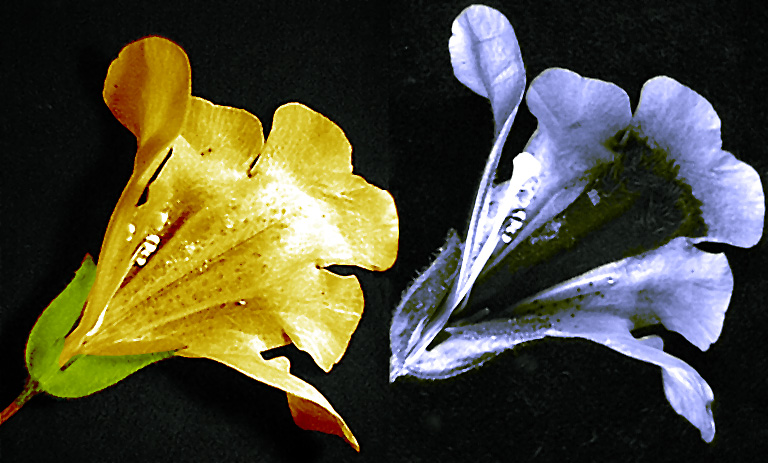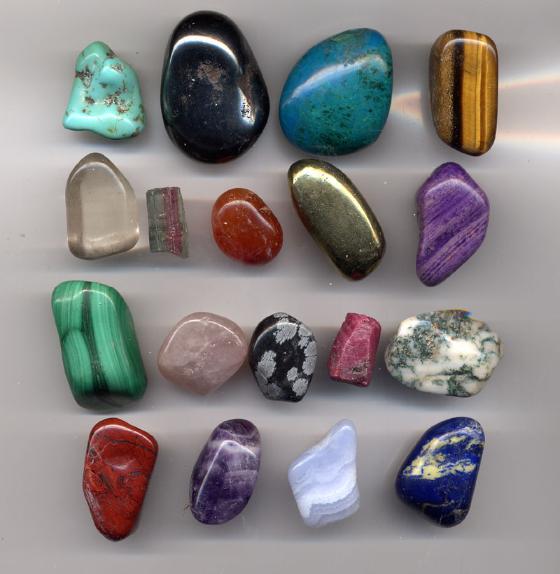Why are things different colours?
Why do different objects we see around us appear to be different colours?
Objects themselves do not create colour (unless they have luminescence – see this section in the Chemistry chapter for more details). What they do is reflect and absorb the spectrum of light waves in different amounts – which includes light waves outside of the human visible spectrum.

For example: a tomato appears to be red because it’s absorbing most of the blue, green and other colour light waves (taking those photons into its atoms) and reflecting red light waves out (Figure 2.17). This is what we detect with our eyes and process with our brains. If it’s night-time and there is no light shining on the tomato, it doesn’t appear red because there are no light waves reflecting off it. The tomato is not generating its own colour. The red colour we see in a tomato comes from a chemical called Lycopene which is a bright red pigment found in other red fruits too. Lycopene absorbs certain light waves and reflects red – this is what we see when we look at a tomato in the light.
It’s the structure of molecules that objects are made of that determines which light waves are absorbed and which are reflected. The electrons within those molecules have energy states that determine which types of energy they can absorb and reflect.
See Additive and subtractive colour systems in this resource for more information.

The reason that most plants and tree leaves are green is because of a pigment called chlorophyll which is used for photosynthesis. Photosynthesis requires red and blue light waves that the plant transforms into chemical energy. The plant doesn’t need the green light waves so this is reflected out and that’s what our eyes detect (Figure 2.18).
Some plants have flowers that reflect lightwaves humans can’t see – like ultraviolet (Figure 2.19). However, certain insects and birds can see these light waves as colours and are attracted to the flowers as a source of food, which also pollinates the plants, or spreads their seeds so they can propagate. The plants have evolved to use this light-reflecting ability to assist their development, just like the insects and birds have evolved the ability to see ultraviolet light waves to assist their growth too.
This website Flowers in Ultraviolet by Bjørn Rørslett, has a very detailed list of flower images showing how they look to humans and how they would look if we could see ultraviolet light waves.

See How animals see colour in this resource for more information.
Gemstones

Just like all other objects, gemstones absorb and reflect light waves and we perceive the reflected waves as different colours (Figure 2.20). Rubies are red and emeralds are green because of the atomic structures of their elements, including impurities that are also mixed in.
To some extent, the colours of gemstones seem to correspond with where they lie on the periodic table of elements. This corresponds with the behaviour of electrons in their atoms. For example, diamonds are made of carbon – which is on the first level of the periodic table – and these elements are usually colourless. Coloured diamonds are due to impurities and imperfections in the stone such as traces of nitrogen, sulphur or boron.
Learn more about gemstone colour from the Gem Society’s Gemology page.

